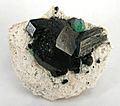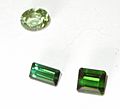Tourmaline facts for kids
Quick facts for kids Tourmaline |
|
|---|---|
 |
|
| General | |
| Category | Cyclosilicate |
| Formula (repeating unit) |
(Ca,K,Na, ▢)(Al,Fe,Li,Mg,Mn)3(Al,Cr, Fe,V)6 (BO3)3(Si,Al,B)6O18(OH,F)4 |
| Identification | |
| Color | Most commonly black, but can range from colorless to brown, red, orange, yellow, green, blue, violet, pink, or hues in between; can be bi-colored, or even tri-colored; rarely can be neon green or electric blue |
| Crystal habit | Parallel and elongated. Acicular prisms, sometimes radiating. Massive. Scattered grains (in granite). |
| Crystal system | Trigonal |
| Tenacity | Brittle |
| Streak | White |
| Diaphaneity | Translucent to opaque |
| Specific gravity | 3.06 (+.20 -.06) |
| Density | 2.82–3.32 |
| Pleochroism |
|
| Dispersion | . |
| Ultraviolet fluorescence | pink stones—inert to very weak red to violet in long and short wave |
| Absorption spectra | Strong narrow band at 498 nm, and almost complete absorption of red down to 640 nm in blue and green stones; red and pink stones show lines at 458 and 451 nm as well as a broad band in the green spectrum |
Tourmaline (pronounced TOOR-mə-lin or -leen) is a cool mineral that forms crystals. It's a type of silicate mineral that contains elements like aluminium, iron, magnesium, sodium, lithium, or potassium.
People often use tourmaline as a semi-precious stone because it's so beautiful. You can find this gemstone in almost every color of the rainbow! Some types of tourmaline can even be magnetic, depending on how much iron they have.
Contents
What Makes Tourmaline Special?
Tourmaline is known for its amazing range of colors. It can be black, brown, red, orange, yellow, green, blue, violet, or pink. Sometimes, a single tourmaline crystal can even have two or three different colors! Imagine a crystal that's pink at one end and green at the other.
How Tourmaline Gets Its Colors
The different colors in tourmaline come from the tiny amounts of other elements mixed in.
- Iron can make tourmaline look blue, green, or black.
- Magnesium often gives it brown or yellow colors.
- Lithium can create beautiful pink, red, yellow, blue, or even clear crystals.
Some rare types of tourmaline can be super bright, like neon green or electric blue. These are very special and sought after.
Where Tourmaline Is Found
Tourmaline crystals usually grow in long, thin shapes. They can be found in different places around the world.
- They often appear in granite rocks.
- Sometimes, they form in veins where hot water has flowed through cracks in the Earth.
Main tourmaline producing countries include Brazil, Afghanistan, Pakistan, Russia, and the United States.
Uses of Tourmaline
Because of its beauty and many colors, tourmaline is very popular for jewelry.
- It's used in rings, necklaces, earrings, and bracelets.
- Collectors also love tourmaline crystals for their unique shapes and colors.
Some people believe tourmaline has special properties, like helping with energy or protection. However, these are beliefs and not scientific facts.
Images for kids
See also
 In Spanish: Turmalina para niños
In Spanish: Turmalina para niños







